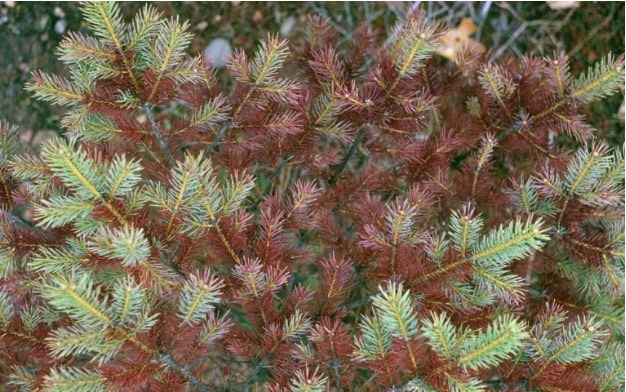The blue spruce tree (Picea Pungens) is a popular coniferous evergreen tree named for its sharp needle leaves. Many homeowners plant them in their yard for ornamental purposes. Its rustic silvery blue color and perfect Christmas tree-like shape make the blue spruce ideal for enhancing the residential and commercial landscape. It also acts as a windbreaker while providing privacy for the areas planted nearby.
A blue spruce tree requires minimal care once its root system is established. However, blue spruces are still susceptible to various infectious diseases that can affect the overall health of the tree.
Here are the most common blue spruce tree diseases to look out for:

-
- Rhizosphaera – This type of fungal disease is probably the most prevalent issue affecting several species of spruce. It’s caused by the fungus Rhizosphaera kalkhoffii and usually appears in the early spring. The needles will turn brownish or purplish brown before dropping from their branches, leaving bare patches in mid-summer. Infected needles have spores that can be easily blown off by wind and spread to healthier trees. This disease affects the scattered lower branches first before travelling upwards.

-
- Cytospora – Cytospora Canker is another type of fungal disease that affects a number of spruce species, but is most common in the Colorado Blue Spruce aged 10 years or older. Like Rhizosphaera, the symptoms usually start at the lower branches of the tree. Infected branches show signs of sunken cankers, which eventually cover the branches with white or bluish white resin. This kills the branches and causes the needles to turn brown before eventually dropping off. Although the fungus rarely kills the tree, it can affect its appearance by thinning the overall fullness of the tree, affecting its appearance.

- Diplodia Blight Disease – Also known as Sphaeropsis tip blight, this is a common fungal disease that is typical in stressed coniferous trees. The Colorado Blue Spruce can be a susceptible host for fungal pathogens that infect and kill the growing needles at the end of the branches, causing them to fall off. This results in the death of the terminal bud. Premature loss of needles results in disfigurement of the tree and loss of vigor. Resin droplets are also seen in dead shoots or buds.
Cutting off the infected part of the tree can prevent and control the spread of disease. While spraying the tree with fungicide can eliminate the problem, it is best to leave the task to professional tree care specialists.
If severe infection is present and at least 50 percent of the tree’s crown is infected, you may need to consider removal and replacement of the tree. Call Caledon Treeland at (905) 880-1828 for professional assistance. We also provide a selection of spruce trees for retail in the GTA, Caledon, Bolton, and surrounding areas.

